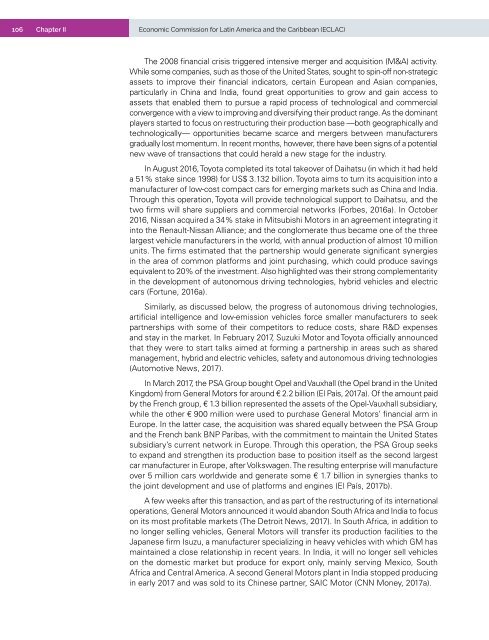Foreign Direct Investment in Latin America and the Caribbean 2017
This publication sets out and analyses the main foreign direct investment (FDI) trends in the countries of Latin America and the Caribbean. The 2017 edition shows that the region is at a difficult juncture. FDI inflows declined by 7.9% in 2016, to US$ 167.043 billion, representing a cumulative fall of 17.0% since the peak in 2011. The fall in commodity prices continues to affect investments in natural resources, sluggish economic growth in several countries has slowed the flow of market-seeking capital, and the global backdrop of technological sophistication and expansion of the digital economy has concentrated transnational investments in developed economies.
This publication sets out and analyses the main foreign direct investment (FDI) trends in the countries of Latin America and the Caribbean. The 2017 edition shows that the region is at a difficult juncture. FDI inflows declined by 7.9% in 2016, to US$ 167.043 billion, representing a cumulative fall of 17.0% since the peak in 2011. The fall in commodity prices continues to affect investments in natural resources, sluggish economic growth in several countries has slowed the flow of market-seeking capital, and the global backdrop of technological sophistication and expansion of the digital economy has concentrated transnational investments in developed economies.
Create successful ePaper yourself
Turn your PDF publications into a flip-book with our unique Google optimized e-Paper software.
106 Chapter II Economic Commission for Lat<strong>in</strong> <strong>America</strong> <strong>and</strong> <strong>the</strong> <strong>Caribbean</strong> (ECLAC)<br />
The 2008 f<strong>in</strong>ancial crisis triggered <strong>in</strong>tensive merger <strong>and</strong> acquisition (M&A) activity.<br />
While some companies, such as those of <strong>the</strong> United States, sought to sp<strong>in</strong>-off non-strategic<br />
assets to improve <strong>the</strong>ir f<strong>in</strong>ancial <strong>in</strong>dicators, certa<strong>in</strong> European <strong>and</strong> Asian companies,<br />
particularly <strong>in</strong> Ch<strong>in</strong>a <strong>and</strong> India, found great opportunities to grow <strong>and</strong> ga<strong>in</strong> access to<br />
assets that enabled <strong>the</strong>m to pursue a rapid process of technological <strong>and</strong> commercial<br />
convergence with a view to improv<strong>in</strong>g <strong>and</strong> diversify<strong>in</strong>g <strong>the</strong>ir product range. As <strong>the</strong> dom<strong>in</strong>ant<br />
players started to focus on restructur<strong>in</strong>g <strong>the</strong>ir production base —both geographically <strong>and</strong><br />
technologically— opportunities became scarce <strong>and</strong> mergers between manufacturers<br />
gradually lost momentum. In recent months, however, <strong>the</strong>re have been signs of a potential<br />
new wave of transactions that could herald a new stage for <strong>the</strong> <strong>in</strong>dustry.<br />
In August 2016, Toyota completed its total takeover of Daihatsu (<strong>in</strong> which it had held<br />
a 51% stake s<strong>in</strong>ce 1998) for US$ 3.132 billion. Toyota aims to turn its acquisition <strong>in</strong>to a<br />
manufacturer of low-cost compact cars for emerg<strong>in</strong>g markets such as Ch<strong>in</strong>a <strong>and</strong> India.<br />
Through this operation, Toyota will provide technological support to Daihatsu, <strong>and</strong> <strong>the</strong><br />
two firms will share suppliers <strong>and</strong> commercial networks (Forbes, 2016a). In October<br />
2016, Nissan acquired a 34% stake <strong>in</strong> Mitsubishi Motors <strong>in</strong> an agreement <strong>in</strong>tegrat<strong>in</strong>g it<br />
<strong>in</strong>to <strong>the</strong> Renault-Nissan Alliance; <strong>and</strong> <strong>the</strong> conglomerate thus became one of <strong>the</strong> three<br />
largest vehicle manufacturers <strong>in</strong> <strong>the</strong> world, with annual production of almost 10 million<br />
units. The firms estimated that <strong>the</strong> partnership would generate significant synergies<br />
<strong>in</strong> <strong>the</strong> area of common platforms <strong>and</strong> jo<strong>in</strong>t purchas<strong>in</strong>g, which could produce sav<strong>in</strong>gs<br />
equivalent to 20% of <strong>the</strong> <strong>in</strong>vestment. Also highlighted was <strong>the</strong>ir strong complementarity<br />
<strong>in</strong> <strong>the</strong> development of autonomous driv<strong>in</strong>g technologies, hybrid vehicles <strong>and</strong> electric<br />
cars (Fortune, 2016a).<br />
Similarly, as discussed below, <strong>the</strong> progress of autonomous driv<strong>in</strong>g technologies,<br />
artificial <strong>in</strong>telligence <strong>and</strong> low-emission vehicles force smaller manufacturers to seek<br />
partnerships with some of <strong>the</strong>ir competitors to reduce costs, share R&D expenses<br />
<strong>and</strong> stay <strong>in</strong> <strong>the</strong> market. In February <strong>2017</strong>, Suzuki Motor <strong>and</strong> Toyota officially announced<br />
that <strong>the</strong>y were to start talks aimed at form<strong>in</strong>g a partnership <strong>in</strong> areas such as shared<br />
management, hybrid <strong>and</strong> electric vehicles, safety <strong>and</strong> autonomous driv<strong>in</strong>g technologies<br />
(Automotive News, <strong>2017</strong>).<br />
In March <strong>2017</strong>, <strong>the</strong> PSA Group bought Opel <strong>and</strong> Vauxhall (<strong>the</strong> Opel br<strong>and</strong> <strong>in</strong> <strong>the</strong> United<br />
K<strong>in</strong>gdom) from General Motors for around € 2.2 billion (El País, <strong>2017</strong>a). Of <strong>the</strong> amount paid<br />
by <strong>the</strong> French group, € 1.3 billion represented <strong>the</strong> assets of <strong>the</strong> Opel-Vauxhall subsidiary,<br />
while <strong>the</strong> o<strong>the</strong>r € 900 million were used to purchase General Motors’ f<strong>in</strong>ancial arm <strong>in</strong><br />
Europe. In <strong>the</strong> latter case, <strong>the</strong> acquisition was shared equally between <strong>the</strong> PSA Group<br />
<strong>and</strong> <strong>the</strong> French bank BNP Paribas, with <strong>the</strong> commitment to ma<strong>in</strong>ta<strong>in</strong> <strong>the</strong> United States<br />
subsidiary’s current network <strong>in</strong> Europe. Through this operation, <strong>the</strong> PSA Group seeks<br />
to exp<strong>and</strong> <strong>and</strong> streng<strong>the</strong>n its production base to position itself as <strong>the</strong> second largest<br />
car manufacturer <strong>in</strong> Europe, after Volkswagen. The result<strong>in</strong>g enterprise will manufacture<br />
over 5 million cars worldwide <strong>and</strong> generate some € 1.7 billion <strong>in</strong> synergies thanks to<br />
<strong>the</strong> jo<strong>in</strong>t development <strong>and</strong> use of platforms <strong>and</strong> eng<strong>in</strong>es (El País, <strong>2017</strong>b).<br />
A few weeks after this transaction, <strong>and</strong> as part of <strong>the</strong> restructur<strong>in</strong>g of its <strong>in</strong>ternational<br />
operations, General Motors announced it would ab<strong>and</strong>on South Africa <strong>and</strong> India to focus<br />
on its most profitable markets (The Detroit News, <strong>2017</strong>). In South Africa, <strong>in</strong> addition to<br />
no longer sell<strong>in</strong>g vehicles, General Motors will transfer its production facilities to <strong>the</strong><br />
Japanese firm Isuzu, a manufacturer specializ<strong>in</strong>g <strong>in</strong> heavy vehicles with which GM has<br />
ma<strong>in</strong>ta<strong>in</strong>ed a close relationship <strong>in</strong> recent years. In India, it will no longer sell vehicles<br />
on <strong>the</strong> domestic market but produce for export only, ma<strong>in</strong>ly serv<strong>in</strong>g Mexico, South<br />
Africa <strong>and</strong> Central <strong>America</strong>. A second General Motors plant <strong>in</strong> India stopped produc<strong>in</strong>g<br />
<strong>in</strong> early <strong>2017</strong> <strong>and</strong> was sold to its Ch<strong>in</strong>ese partner, SAIC Motor (CNN Money, <strong>2017</strong>a).


















